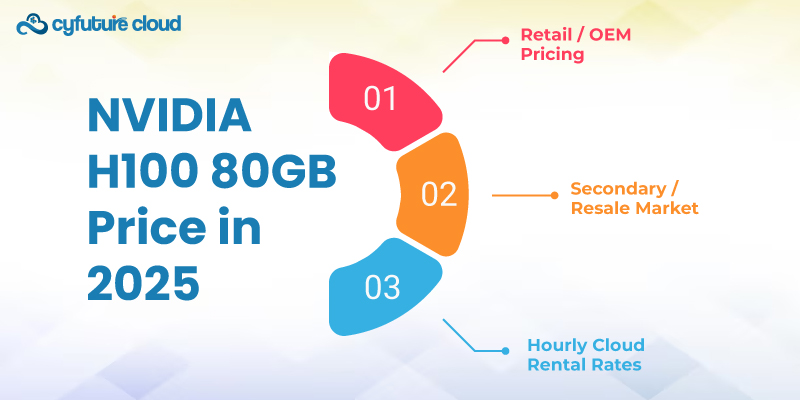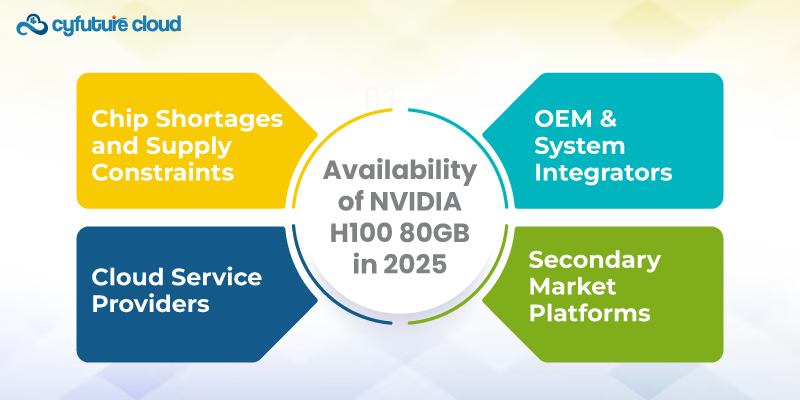 Server
Colocation
Server
Colocation
 CDN
Network
CDN
Network
 Linux Cloud
Hosting
Linux Cloud
Hosting
 VMware Public
Cloud
VMware Public
Cloud
 Multi-Cloud
Hosting
Multi-Cloud
Hosting
 Cloud
Server Hosting
Cloud
Server Hosting
 Kubernetes
Kubernetes
 API Gateway
API Gateway

As the demand for AI computing and high-performance GPU servers continues to rise, the NVIDIA H100 GPU remains one of the most sought-after accelerators for AI model training, data analytics, and machine learning applications.
With new market fluctuations, inventory shortages, and updated vendor listings, it’s essential to stay informed about the Nvidia H100 Price 2025 List Price and real-time availability across global and Indian markets.
This article provides a detailed update on the NVIDIA H100 GPU Price in 2025, including the Nvidia H100 80GB Price 2025, availability status, and factors affecting the pricing trend.
We’re about to end 2025, and the AI hardware ecosystem is more competitive than ever. As enterprises deploy large language models (LLMs), generative AI, and advanced computer vision pipelines, demand for high-end NVIDIA GPUs has surged dramatically.
NVIDIA H100 80GB GPU, built on the Hopper architecture, has become the go-to accelerator for cutting-edge AI and HPC workloads. But in 2025, with newer chips like the H200 entering the market and cloud GPU hosting expanding, CTOs and AI leaders are asking two key questions:
◾ What is the NVIDIA H100 80GB price in 2025?
◾ How available are H100 units today?
This article answers both, with up-to-date pricing, availability insights, and strategic recommendations for on-premise, cloud, and hybrid deployments.

The cost of the NVIDIA H100 80GB GPU in 2025 varies depending on whether you buy new, through OEMs, or via secondary markets.
According to current market data, as of early 2025, the list price for a single NVIDIA H100 GPU (PCIe 80 GB variant) is approximately $25,000–$30,000. These figures are based on current MSRP and verified through major system integrators and reseller platforms.
However, real-world prices often vary:
Premium PCIe units may cost $30,000–$35,000 due to limited supply.
Bulk pricing or contracts (e.g., OEMs like Dell, Supermicro) can bring effective per-unit cost down to $22,000–$24,000 if deploying 4, 8, or more cards at once.
With demand exceeding supply, many enterprises look to resale or secondary marketplaces. However:
H100 introductory listings start near $40,000.
Used units still command $30,000+, depending on condition and warranty status.
So far, secondary marketplaces remain attractive only for urgent deployments, as unit condition and longevity remain a concern.
If you’re considering Cloud GPU hosting, here’s what you’ll pay (approximate 2025 pricing):
|
Provider |
GPU Type |
Hourly Rate (USD) |
|
AWS EC2 (p5 instance) |
H100 |
$7.50/hr |
|
Azure NC-series |
H100 |
$7.00/hr |
|
Google Cloud A3 |
H100 |
$7.20/hr |
|
RunPod / Vast.ai |
H100 |
$4.00–$5.00/hr |
These rates often include associated server resources (vCPUs, RAM, networking)—making launch times almost instant.
Nvidia H100 80GB Price 2025 – Market Insights
The Nvidia H100 80GB Price 2025 has seen a gradual increase due to supply-demand imbalance and limited chip manufacturing capacity. AI-driven companies and research institutions continue to invest heavily in these GPUs to scale model performance.
Key Market Highlights (2025):
◾ Global demand up by 35% year-over-year, driven by LLM (Large Language Model) training.
◾ Increased pricing from OEMs and cloud providers due to limited production capacity.
◾ Discounts available on bulk purchases for enterprise data center deployments.
|
Model |
Memory |
Availability |
Price Range (India) |
|
NVIDIA H100 80GB PCIe |
80GB HBM3 |
Limited |
₹24,00,000 – ₹26,00,000 |
|
NVIDIA H100 80GB SXM |
80GB HBM3 |
Moderate |
₹27,00,000 – ₹29,00,000 |
|
NVIDIA H100 NVL |
2×80GB HBM3 |
Rare |
₹40,00,000+ |

From late 2023 to mid-2024, the global semiconductor supply chain remained heavily constrained. While shortages have eased, H100 supply is still tight:
◾ OEMs and cloud providers maintain allocation priorities.
◾ Enterprise pre-orders often face 4–8 month lead times.
◾ Secondary market units are selling faster than they come in.
◾ Global OEMs like Dell, HPE, and Supermicro have received steady H100 shipments, but prioritize high-volume clients.
◾ If your organization needs 4+ GPUs, integrating in a DGX node or Supermicro GPU server, expect 4–6 weeks’ availability to ship, provided inventory is in regional warehouses.
Most major providers offer immediate H100 rentals—but availability may fluctuate:
◾ AWS and Azure throttle access during peak usage (e.g., Wednesday India time).
◾ Smaller GPU-focused clouds (RunPod, Lambda Labs) offer on-demand H100s, but often with queue times—especially when promos or startup credits drop.
◾ Platforms like eBay, ServerMonkey, and enterprise brokers list used units. Vendors often guarantee uptime, but these units lack full warranty.
◾ Due to demand, fresh listings sell within days, keeping resale availability narrow.
Let’s break down the trade-offs:
◾ Cost: $25,000+ per GPU (CapEx heavy)
◾ Best for: Teams using >300 GPU hours/month
◾ Pros: Full control, lower cost at scale, secure environment
◾ Cons: High upfront investment, longer deployment cycle
◾ Cost: ~$7/hr ≈ $5,000/month per GPU (if used 24/7)
◾ Best for: Flexible workloads, startups, researchers
◾ Pros: Instant access, scalability, no maintenance
◾ Cons: High Opex over time, vendor lock-in
Hybrid strategy: Many enterprises run baseline inference on-prem while using cloud GPU rentals for training and burst workloads, striking the right balance between cost and flexibility.
If you’re pursuing H100 acquisition, these strategies help:
◾ Align with OEM planning cycles – Quarterly/inventory ordering is vital
◾ Pre-order multiples – Leverage bulk commitments to secure shorter lead times
◾ Use specialty Cloud GPU providers – They scale faster and often meet requests days after.
◾ Analyse your workload use – If it’s intermittent, cloud-only may be more cost-effective.
◾ Watch for grants/startup credits – Some big providers run GPU credits through startup programs (e.g., AWS Activate).
Several factors are shaping future H100 pricing:
The release of H200 may push H100 prices down slightly—MSRP could drop 5–10% through 2026
Improved manufacturing output for Hopper chips is reducing scarcity
Market factors (economic slowdown, rising hydrogen futures) could further impact GPU demand
My view: By late 2026, MSRP may reach $22,000–$24,000, with improved OEM shipping windows. Until then, expect prices to remain robust through 2025.
Analysts expect a 5–10% price decline by late 2025, as NVIDIA introduces next-generation GPUs and optimizes production. However, for AI-intensive workloads, the Nvidia H100 80GB Price 2025 may remain high due to sustained enterprise demand.
|
Period |
Expected Price Trend |
Availability Outlook |
|
Q1 2025 |
Stable |
Low inventory |
|
Q2 2025 |
Slight increase |
Moderate availability |
|
Q3 2025 |
5% drop expected |
Improved distribution |
|
Q4 2025 |
Stable pricing |
Wider access globally |
The NVIDIA H100 GPU remains the top-tier choice for leading-edge AI workloads. As of mid-2025:
MSRP: ~$25k–30k per unit
Cloud rental: ~$7/hr
Availability: OEMs prioritise volume contracts; cloud access is immediate but usage-based
If you need guaranteed access, full control, and 24/7 performance, on-prem bare metal setup still makes sense—especially if your usage exceeds 300 hours/month per GPU. For variable workloads or experimentation, Cloud GPU hosting provides flexibility and instant access.
Strategic hybrid deployments—baseline local inferencing, cloud-based train/burst—offer the best balance of pricing, availability, and scalability.
Need help architecting AI infrastructure or sourcing H100-equipped servers? Cyfuture Cloud offers both GPU server hosting and access to cloud GPU instances with transparent pricing and guaranteed availability.
The Nvidia H100 GPU continues to dominate the AI hardware market with unmatched performance and energy efficiency. However, due to growing demand and production limitations, both the Nvidia H100 Price 2025 List Price and Nvidia H100 80GB Price 2025 remain premium investments.
For organizations requiring scalable AI infrastructure without heavy upfront costs, GPU Cloud Hosting through providers like Cyfuture Cloud offers an ideal alternative, providing instant access to H100 GPUs for AI, ML, and HPC workloads.

Let’s talk about the future, and make it happen!
By continuing to use and navigate this website, you are agreeing to the use of cookies.
Find out more


